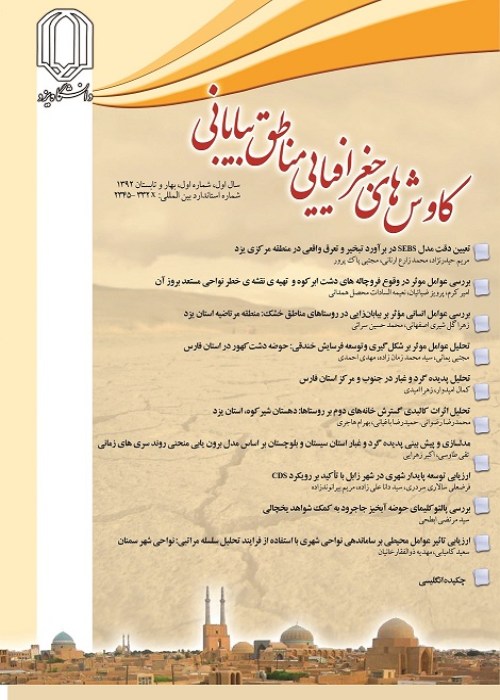Development of management strategies for protection and rehabilitation of Jazmourian lagoon using the VIKOR multi-criteria decision model
The special and critical ecological conditions of Jazmourian lagoon are considered as serious environmental challenges across the region. So, taking practical measures in this case is inevitable. To that end and in order to achieve sustainability in water resources and all the other environmental factors there, adopting sustainable and adaptive policies should be the center of any action plan. Jazmourian, with its specific structure and an area of 3300 square kilometers, is one of the seasonal lagoons located among Sistan and Baluchestan and Kerman provinces. Due to climatic changes and the construction of several dams to feed upstream rivers including Jiroft dam in Kerman Province and Karvandar dam in Sistan and Baluchestan Province, the lagoon has faced serious environmental challenges. According to the surveys, this area is considered as one of the dust centers in the southwest of Iran, and it will completely dry up in case of any continuation in drought conditions and lack of treatment measures. Lack of purposeful and capable management strategies is known as one of the destruction causes where the measures envisaged for the operation or even protection of wetlands do not lead to desired results in many cases. In addition, management of a lagoon, unlike other natural ecosystems, is significantly dependent on the upstream activities. Any development activities or resource utilization across the upstream catchments leading to a lagoon has significant consequences. Therefore, the development of action plans concerning lagoon management should be based on comprehensive approaches on a basin scale. While lagoons provide many ecosystem services, they have been subjected to high pressures across the world; it has been well documented and demonstrated in some cases. Therefore, it is necessary to do research on those areas, especially on Jazmourian, which has received less attention than other lagoons. However, in some places, due to lack of data, evaluation has not been done. A structural and comprehensive method is, thus, needed to collect and analyze the data and guide users through a comprehensive environmental assessment of the place. An action plan is also needed to highlight the lack of data and identify susceptible areas for prioritization. The aim of the present study is to comprehensively evaluate the capabilities and bottlenecks for the protection and optimal management of Jazmourian lagoon using the VIKOR multi-criteria decision model.
Library and document studies were conducted as the method of data collection in the present study and an attempt was made to control some data and to achieve some mental realization of the lagoon and its conditions. Field surveys and interviews were performed with some experienced managers and experts in lagoon management using a questionnaire. Then, through field study and observations, five effective managerial indicators were identified. Afterward, by using DPSIR indicators and the Vickor model, the data analysis and identification and prioritization of the indicators were performed, and management solutions and suggestions were adopted.
The indicators of the DPSIR model are pressure, driving force, position, effect and response. The pressure index, the driving force, position, effect index and response in the model are benefited by 4, 9, 1, 5 and 12 components respectively (Table 1). The components of the DPDIR model and the average rankings of the indicators related to driving force, pressure, status, effect and response are listed in Table 2. Among the model components, the situation, pressure, response, effect and driving force sections with an average of 4.26, 4.24, 4.18, 4.07 and 3.89 are ranked from first to fifth respectively. The driving force of the component is the lack of coherent management with a score of 4.20 in the first place, the pressure of the disruption component of the upstream and downstream watershed with a score of 4.40 in the first place, the effect of the components of increasing dangerous diseases and increasing fine dust with scores of 4.60, 4.53 in the first and second ranks, the response of the component of construction of small dams instead of large ones with a score of 4.70 were in the first rank. Then, the extracted solutions were ranked using the VIKOR method. The result of VIKOR concerning the evaluation and hierarchy analysis of the management strategies revealed that maintaining and restoring native vegetation with zero weight reached the highest priority and was laid in the top of the hierarchical analysis. Then, public participation in watershed management with a weight of 0.119, construction of small dams instead of large ones with a weight of 0.179, job opportunity creation in the service and handicrafts sector with a weight of 0.196, arranging drilled wells with a weight of 0.312, cultivation of cost-effective plants in terms of virtual water with a weight of 0.205, expansion of the use of modern irrigation systems with a weight of 0.237, determination of real water prices in the agricultural sector with a weight of 0.488, the use of treated wastewater for irrigation with a weight of 0.509, development and expansion of greenhouse and sub-plastic cultivation with a weight of 0.742 and, finally, the solution of cementing, covering and piping of streams with a weight of 1 were sequentially the second priority.
Applying ecological management (conservation approach) along with engaging the indigenous communities of the region in management processes have been presented as the best management method.
- حق عضویت دریافتی صرف حمایت از نشریات عضو و نگهداری، تکمیل و توسعه مگیران میشود.
- پرداخت حق اشتراک و دانلود مقالات اجازه بازنشر آن در سایر رسانههای چاپی و دیجیتال را به کاربر نمیدهد.




